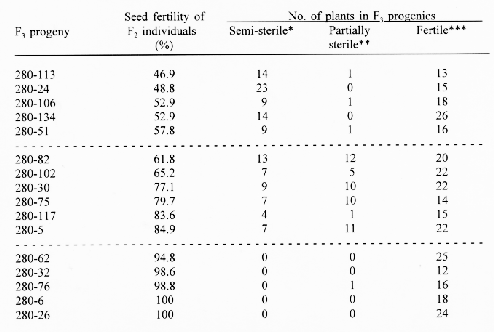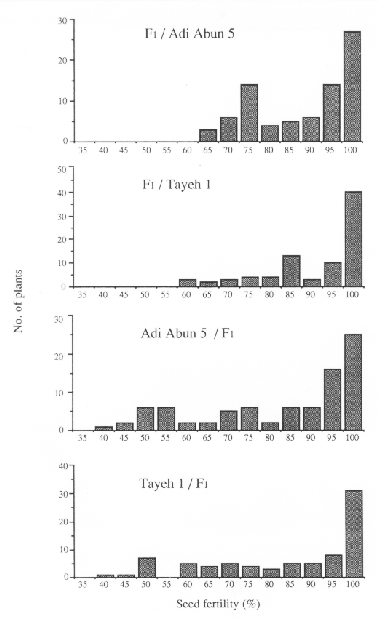

Konishi and Fukushima (1992) found partially sterile F1 plants derived from cross combinations between some Ethiopian accessions and a Chinese landrace, Tayeh 1, although all the parents were completely fertile. Their F2 individuals were classified into three groups by seed fertility: semi-sterile, partially sterile, and fertile ones. From their segregation frequencies, a model of inheritance for the hybrid sterility was proposed as follows: Tayeh 1 and each of the Ethiopian accessions possesses AAbb and aaBB genotype for the hybrid sterility respectively. Only the AB female gamete of the hybrid is lethal, and seed fertility is determined by frequency of the AB female gametes.
The present investigation was undertaken to confirm the model mentioned above, using some F3 progenies and B1F1 plants. Out of F2 individuals derived from a cross combination between Mota 10 (one of the Ethiopian accessions) and Tayeh 1, 16 individuals that differed in seed fertility were chosen, and segregation of plants in each F3 progeny was examined for seed fertility. As shown in Table l, semi-sterile and fertile plants segregated in F3 progenies derived from the semi-sterile F2 individuals, and semi-sterile, partially sterile, and fertile plants appeared in F3 progenies of the partially sterile F2 individuals. All plants in F3 progenies of fertile F2 individuals were fertile.
Meanwhile, seed fertility of B1F1 plants was investigated, which were derived from reciprocal backcrosses between Tayeh 1 (AAbb) and Adi Abun 5(aaBB). The B1F1 plants were classified into partially sterile and fertile groups, when the F1 plants were used as the female parent. On the other hand, when F1 plants were used as the male, semi-sterile, partially sterile, and fertile plants were observed (Fig. 1).
From these results, it is concluded that the hybrid sterility is controlled by two complementary genes, A and B, both of which are independently inherited, and that the semi-sterile individuals possess either AABb or AaBB genotype for the hybrid sterility, while the partially sterile individuals carry AaBb genotype as F1 plants. Genotype of fertile individuals is thought to be either one of Aabb, aaBb, and aabb. The hybrid sterility is caused by the lethal female gamete of AB genotype. We propose that A and B genes be designed as Lfg1 and Lfg2, respectively.
Reference:
Konishi, T., and Y. Fukushima. 1992. Genetic analysis of hybrid sterility in barley. BGN 21 :51-53.

